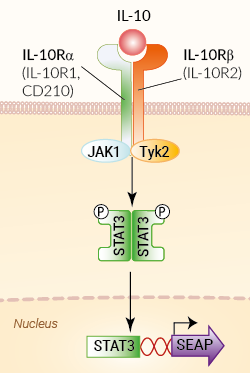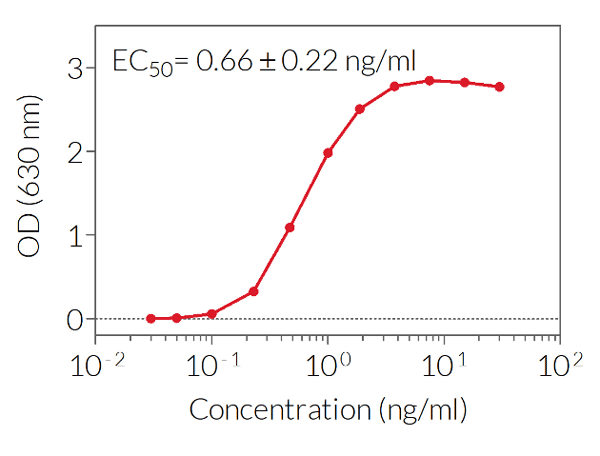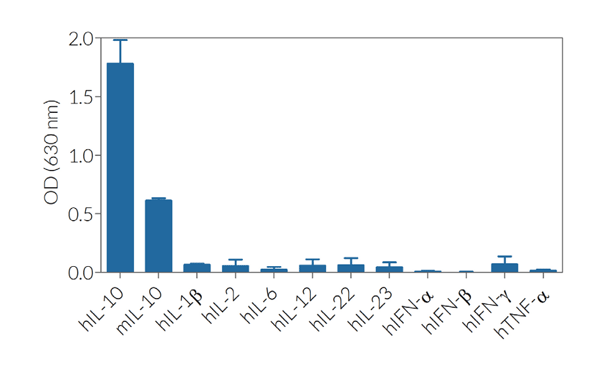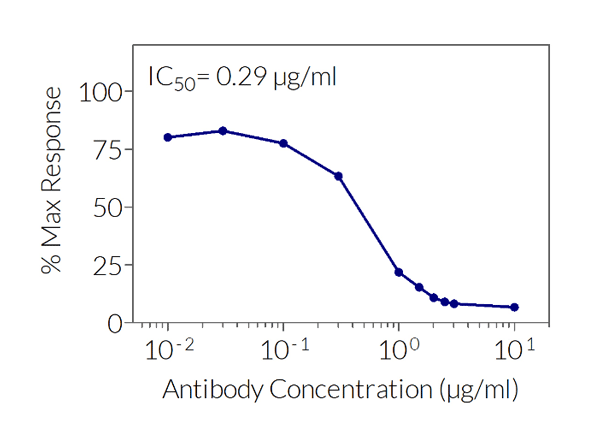IL-10 Reporter HEK 293 Cells
| Product | Unit size | Cat. code | Docs. | Qty. | Price | |
|---|---|---|---|---|---|---|
|
HEK-Blue™ IL-10 Cells Human IL-10 Reporter Cells |
Show product |
3-7 x 10e6 cells |
hkb-il10
|
|
||
|
HEK-Blue™ IL-10 vial Additional cell vial |
Show product |
3-7 x 10e6 cells |
hkb-il10-av
|
Notification: Reference #hkb-il10-av can only be ordered together with reference #hkb-il10.
IL-10 Reporter Cells

Signaling pathway in HEK-Blue™ IL-10 cells
HEK-Blue™ IL-10 cells were engineered from the human embryonic kidney HEK293 cell line to detect bioactive human interleukin 10 (IL-10) by monitoring the activation of the STAT3 pathway. In addition, these cells can be used for screening antibodies or small molecule inhibitors targeting the IL-10 pathway.
IL-10 is an anti-inflammatory cytokine with a crucial role in preventing inflammatory and autoimmune pathologies [1, 2].
Cell line description
HEK-Blue™ IL-10 cells were generated by stable transfection of the human embryonic kidney HEK293 cell line with the genes encoding hIL-10R α and β chains, human STAT3, and the STAT3-inducible SEAP (secreted embryonic alkaline phosphatase) reporter.
The binding of IL-10 to its receptor on the surface of HEK-Blue™ IL-10 cells triggers JAK1/STAT3 signaling and the subsequent production of SEAP. This can be readily assessed in the supernatant using QUANTI-Blue™ Solution, a SEAP detection reagent.
HEK-Blue™ IL-10 cells detect human (h) IL-10 and, to a lesser extent, murine (m) IL-10 (see figures). These cells are not responsive to hIL-1β, hIL-2, hIL-6, hIL-12, hIL-22, hIL-23, hIFN-α, hIFN-β, hIFN-γ, and hTNF-α (see figures).
Key features
- Fully functional IL-10 signaling pathway
- Readily assessable STAT3-inducible SEAP reporter activity
- Response to human (h) IL-10 and, to a weaker extent, murine (m) IL-10
- No response to hIL-22
Applications
- Detection and quantification of human and murine IL-10 activitiy
- Screening of anti-IL-10 and anti-IL-10R antibodies
- Screening of small molecule inhibitors of the IL-10 pathway
References:
1. Saraiva M, et al., 2019. Biology and therapeutic potential of interleukin-10. J. Exp. Med. doi: 10.1084/jem.20190418.
2. Ouyang W & O’Garra A, 2019. IL-10 family cytokines IL-10 and IL-22: from basic science to clinical translation. Immunity. 50:871-91.
Specifications
Antibiotic resistance: Blasticidin, Hygromycin B Gold, Zeocin®
Growth medium: DMEM, 4.5 g/l glucose, 2-4 mM L-glutamine, 10% (v/v) heat-inactivated fetal bovine serum, 100 U/ml penicillin, 100 μg/ml streptomycin, 100 μg/ml Normocin™
Guaranteed mycoplasma-free
Specificity: human and mouse IL-10
Detection range:
- 0.3 - 30 ng/ml for human IL-10
- 25 - 1000 ng/ml for murine IL-10
Contents
- 3-7 x 106 HEK-Blue™ IL-10 cells in a cryovial or shipping flask
- 2 x 1 ml of HEK-Blue™ Selection (250x concentrate)
- 1 ml of Normocin™ (50 mg/ml). Normocin™ is a formulation of three antibiotics active against mycoplasma, bacteria, and fungi.
- 1 ml of QB reagent and 1 ml of QB buffer (sufficient to prepare 100 ml of QUANTI-Blue™ Solution, a SEAP detection reagent)
![]() Shipped on dry ice (Europe, USA, Canada and some areas in Asia)
Shipped on dry ice (Europe, USA, Canada and some areas in Asia)
Details
Interleukin 10 (IL-10), is the founding member of the IL-10 cytokine family, which comprises IL-10, IL-19, IL-20, IL-22, IL-24, IL-26, IL-28A (IFN-λ2), IL-28B (IFN-λ3), and IL-29 (IFN-λ1)1. IL-10 was originally depicted as a key mediator of anti-inflammatory responses. While the immunosuppressive action of IL-10 is illustrated by its genetic association to inflammatory bowel disease, or its upregulated expression in chronic infections, an unanticipated IL-10 protective role has been reported in cancer [1].
IL-10 also plays important homeostatic roles in non-immune cells, including neurons, adipocytes, and epithelial cells [1]. The manipulation of IL-10 production and signaling has thus become an attractive therapeutic strategy [2].
Upon IL-10 binding, the IL-10Rα chain oligomerizes with the IL-10Rβ chain. This in turn allows the phosphorylation of JAK1 (Janus kinase 1) and TyK2 (Tyrosine kinase 2), and the subsequent activation of STAT3 (Signal transducer and activator of transcription 3) [1]. Importantly, STAT3 is also activated downstream of other cytokine receptors. How the cells trigger distinct and specific gene expression in response to cytokines signaling through the same transcription factor is not fully understood yet [1].
1. Saraiva M, et al., 2019. Biology and therapeutic potential of interleukin-10. J. Exp. Med. doi: 10.1084/jem.20190418.
2. Ouyang W & O’Garra A, 2019. IL-10 family cytokines IL-10 and IL-22: from basic science to clinical translation. Immunity. 50:871-91.










